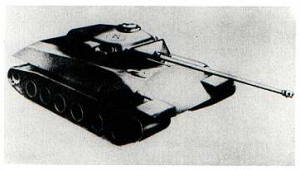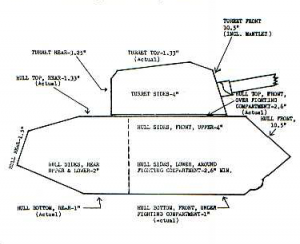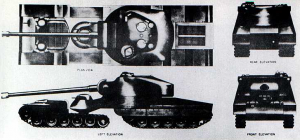On January 2nd, 1945 the US Army Ground Forces Equipment Review Board outline requirements for a new class of tanks, and on June 20th they reported that they suggest that American Armored Forces have a 25 ton light tank, a 45 ton medium tank, a 75 ton heavy assault tank, and wanted to research a 150 ton super heavy tank. In 1946, the Stilwell Board dropped the plans for the 150 ton vehicle along with tank destroyers and had American tank development loosely follow the requirements set forth by the AGF up until requirements changed in the year 1950.
So first off lets discuss the 25t vehicle. The AGF’s 25t tank was to replace the M24 which was inadequate, especially in the firepower department. The proposed gun was to be a 76 mm cannon that was to penetrate 127 mm @ 914 meters against a 30 deg. sloped plate. Mobility was also suppose to be better than the Chaffees. I actually mentioned this project before in this article, because the AGF’s 25t proposal quickly developed into the T37 and later into the M41 Walker Bulldog.
The 45t vehicle had some interesting features. First of all the armor protection was very thick. The frontal hull was to have 203 mm thick armor. There is some ambiguity whether this is to factor in slope or not. The gun for this 45t tank is also very interesting. It was to be a high velocity 76 mm cannon which could penetrate 203 mm @ 914 m against a 30 deg. sloped plate. I have concluded that this penetration requirement refers to HVAP shells rather than AP, but I could be wrong. The gun was also to be stabalized and was to have a rangefinder. Another interesting piece of info is that this gun was to have an autoloader, but was to retain all 5 crewmen. The 45t vehicle was to have a remote controlled bow .30 cal MG as well as .30 cal “blisters” on the side of the turret.
The 75 ton vehicle was another oddity. This behemoth was to have 5 crew members and was to have a top speed greater than 30 km/h. The main gun was requested to be a 90 mm gun that could penetrate 267 mm @ 1828 meters against a 30 deg. sloped plate with HVAP shells. This is ~100 more mm than the T15E1/T15E2 guns in the same conditions with HVAP shells. Accuracy of the 75t tank was to be excellent. Reasonable accuracy was to be maintained up to ranges near 3.5 km. The armor of the vehicles was to be equal to at least 267 mm at zero slope.
I have touched on the 150 ton project before, but I forget which article I mentioned it in. Anyways the 150t vehicle was to be armed with anywhere from a 105 mm gun to a 155 mm gun. Whatever gun was mounted, there was to be a duel autoloading system(as in the T22 medium tank) for quick changes between ammo types. A stabilizing system was also to be used. Armor was to be as heavy as weight and mobility requirements allowed. The conceptual art featured in the June 20th report had a semi-trailer layout which was thought to be necessary for transportation for a 150 ton vehicle.
In the title I called these tanks the American “E Series”. One can make parallels between the AGF’s proposals and Wa Pruef 6′s proposals for tanks based on weight class. Both projects had some actual vehicles built like the T37 and parts of the E 10, E 25, and E 100; but a large amount of these projects’ attributes remain shrouded and ambiguous. I would also like to say that the AGF likely never took the E Series into consideration when coming up with these requirements. It is just a case of two groups coming up with somewhat similar solutions to somewhat similar problems.
Sources:
Hunnicutt’s Sheridan, Patton, and Firepower books.




Now I know where did Global Defense Initiative and USSR take design for Mamont tank lol
IF IT DOESN’T HAVE DUAL MAIN GUNS IT DOESN’T COUNT. EVER.
Someone in the american engineering bureau went nuts.
Why not , 150 ton project is like 2 tanks , So you can get money for 2 tanks in your pocket xD
The 150-tonner is made of WTF and awesome. :o
Nitpick: AFAIK the E-100 basically had no relation of any kind to the much later “standardpanzer” E-family…
I’ll fix that when I get off work.
Except that it was to share many components with E-75 maybe>?
I was under the impression it was the E-50 and -75 that were supposed to share as many parts as possible… be that as it may, the mid-war superheavies were long since cancelled by the time the “E-family” got concepted.
Im pretty sure i read it somewhere: E 75 and 100 were to use the same production lines and share lots of components. And by extension they would share theese components with E-50, wich in turn was to share them with E-25 and E-10. That was the idea of the standartpanzer.
Yeaaaaahno. The E-100 got the axe already in whatwasitnow, early ’43 or so – the manufacturer kept working on the proto hull anyway as more or less a private project, but at *very* low priority; it was still far from finished when the Allies captured the factory in ’45. Also MUCH larger than the Kingtiger-sized E-75 was planned to be, so kinda hard to see where too much stuff could be shared…
The E-50 and -75 OTOH were virtually the same tank except the latter was to have thicker armour and perhaps bigger gun for the heavy-tank role. Pretty sure they had in technological terms little in common with the lighter members of the family, which were instead planned as replacements for eg. the existing crop of TDs/assault guns (StuGs, Hetzers…) as was the case with the little E-25.
What was shared was the suspension pack, pretty much always the same, just different number of roadwheels.
How would that 150 ton tank rotate? o.O
Rather easier than a conventional hull of such dimensions I’d say. Big trucks and similar large, long ground vehicles are articulated for a reason you know.
5 “easy” step to turn the tank:
1. Shut down the engine in the back part.
2. Turn the front part to the direction you want.
3. Restart engine in the back
4. Use front part as ‘the lead” and back part as “gravity point”, turning the tank
5. when turning done, turn the front part back straight with the back, start moving
it’ll take may be 15 min to turn left or right IRL , and epic fail in CQC, when it turn in corner in city.
Well now that you’ve explained it, it seems so easy!
Because you totally can’t electronically synchronise the front and back engines via the rotary joint or anything.
Also good luck maneuvering a rigid hull of comparable dimensions…
I have to ask why did you say M24 gun was inaqequate? It was on same class as M4 75mm gun.
And certainly very good for such light vehicle.
By that date that level of firepower was decidedly lackluster if you wanted to be able to shoot at other tanks you know. The French put a rather higher-velocity 75mm gun into the AMX-13 and it didn’t take all that long before that got replaced by a 90mm job on account of insufficiency.
long live Hunnicutt!
That 45t actually looks really cool, sort like an American version of the Centurion. I can totally see that in the next American medium line, whenever that comes out.
that 75t is a BDR G1B on steroids
FIRST?
I’m guessing the 203mm is LOS protection for a sloped plate, 4″ @60 degrees like the M47 maybe (which, incidentally, is in that weight class)?
Pretty much what I was thinking.
I could see the 25 ton, 45 ton and 75 ton designs being incorporated into the game at some point (in a sense the 25 ton design is confirmed as the M41 Walker Bulldog is due to be added in a future update).
The 150 ton design…that’s another story. If WG decides to implement it it would require a completely-unique playstyle, since it would essentially be like driving a vehicle pulling a trailer, which will make maneuvering, particularly if you need to turn around, VERY time-consuming.
What would be the benefit of tracks like that, compared to the usual ones?
That 150t… What the actual fuck.
The idea seems to be getting a lot of track contact area ergo low ground pressure without the well-known problems associated with high lenght-to-width ratios. Kind of a Rube Goldberg solution though.
So the 150t design is essentially a tank…mounted on another tank.
*Insert Yo Dawg/Tankception pic here*